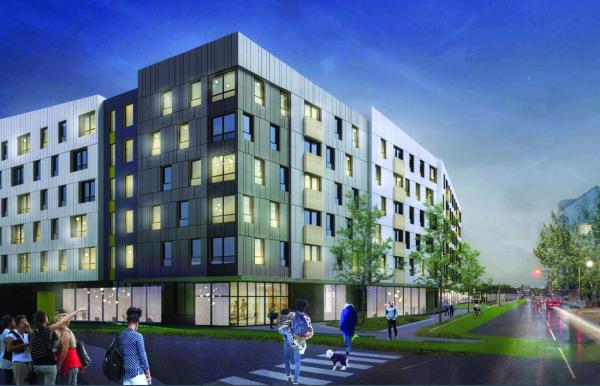December 21, 2017

Architectural rendering shows proposed first building in plan for mixed-use project in Mattapan.
There was action last week on the plan to transform the 2.57-acre MBTA parking lot in Mattapan Square into a sprawling mixed-use development.
The first Impact Advisory Group meeting on the project on Thursday featured residents quizzing the team on transit, environmental impacts, and community benefits.
Nuestra Communidad Development Corporation and the Preservation of Affordable Housing Inc. (POAH) are developing the River Street lot into a $57 million combination of housing, green space, and retail.
“They have joined forces in an effort to build upon what makes the Mattapan neighborhood so important – its diversity and the strength of its residents,” a city filing reads. “This proposed mixed-use, mixed-income rental project will help to leverage local opportunities for growth and expansion by adding jobs, creating commercial and retail services, and providing stable affordable and workforce housing.”
The developers, following the Boston Planning and Development Agency’s Article 80 process, kicked things off in August with a Letter of Intent, then submitted their expansive project proposal in late September.
The Nuestra/POAH partnership plan calls for 50,000 square feet of new construction across two buildings, the first including 135 units of mixed-income rental housing, 10,000 square feet of commercial or retail space, and a 2,000-square foot community room. The second building will include nine homeownership units and six parking spaces.
A mid-rise building would climb from five stories along River Street to six stories at the south elevation, where it abuts the MBTA bus stop and trolley platform. As laid out in the city filing, this building includes two townhouses and 133 multi-family units on floors two through six.
The residential housing — of which at least half will be affordable to those making 60 percent of area media income or less — will include studios, one-, two- and three-bedroom units to support both single households and families.
As presented to some 30 individuals who attended the meeting, monthly rents will likely range from $1,086 for a studio to $1,613 for a three-bedroom.
Julie Creamer, POAH’s vice president of new construction and special projects, said the meeting “went very well. We have a very great group of IAG members, all or most of them 20-plus year residents of Mattapan. They asked great questions, poignant and very forward-thinking, centered primarily around making sure that the project delivers benefits to the community.”
Some of the conversation centered on potential environmental impacts from the project, which sits near the Neponset River, its proximity to the newly completed Neponset River Greenway, and access to public transit.
The site is alongside the chaotic intersection of River Street, Blue Hill Avenue, and Cummins Highway. Traffic, therefore, is a concern for the IAG members, Creamer said, although, she said, the projects teams’ traffic consultant’s opinion is that “this amount of housing really isn’t going to worsen an already bad situation.”
Nuestra/POAH’s traffic study estimated 610 additional vehicle trips per day for the residential component, and 292 trips per day for retail purposes.
Walking, biking, and public transit would account for 568 trips across the day, the study found.
Cars will have access to 70 underground parking spaces for residential use, 50 surface parking spaces for MBTA commuters, and pick-up/drop-offs for MBTA buses through the existing bus entrance on River Street, west of the project. Vehicles would leave the site through the existing driveway onto River Street to the east. Additionally, a vestibule with standard bicycle storage and condensed bicycle storage could hold about 135 of them on the property.
“We did evaluate the needs there, and recognize that a [Transit-Oriented Development] site is actually a benefit,” Creamer said. “Hopefully, folks will not be driving and relying more on trolley and bike paths.”
Creamer expects there will be one or two more public IAG meetings later this winter, ideally in January. The developers plan to apply to the state Department of Housing and Community Development in February for additional funding, but they want to wait until the IAG has finished reviewing their proposal.
The project is still in the design phase, which is expected to continue through next September. If all goes according to schedule, an 18-month construction window would conclude in early 2020.


